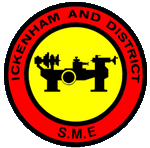
Last updated on
20th March 2020

A Brief History of IDSME
The Ickenham and District Society of Model Engineers was founded in 1948. The inaugural meeting was held on 8th October 1948 in the ARP hut on Swakeleys Road, Ickenham. Known originally as The Ickenham & Ruislip Model Club, the name was changed to the current one within the year, following visits from gentlemen seeking an entirely different sort of model.
Meetings continued to be held in the ARP hut until early 1949, when the society was able to move to a room in Ickenham Hall. At the time the Hall was run by the Ickenham Community Association and many local societies were able to hold their meetings there. The Hall is now part of the Compass Theatre.
The society held its first public exhibition in the Ickenham Village Hall on 14th May 1949 and this continued as the venue for the Society’s annual exhibition for several years. A further change of venue for the society’s meetings occurred at the end of the year when we moved to the Memorial Hall, across the road from what is now The Old Fox.
In 1953 moves began to find the society a permanent home. Discussions were held with the local council, but in November hopes were pinned on a mystery site in Ickenham. In January 1954 the site was announced as being behind the Coach and Horses’. During the ‘secret’ negotiations the emphasis had been on renting the land but now the owner was interested in selling the property. The society's business machinery came into use arranging a bank loan, guarantors and planning permission for a building of concrete blocks. After one or two minor setbacks in planning and access problems, work on the site started on 24th April 1954.
|
At the end of May the last meeting at the Memorial Hall was held and during the summer activity was concentrated on building the new headquarters. The 1954 A.G.M. on 28th September was the first official meeting to be held in the new headquarters. Electricity was provided by a petrol driven generator. That winter, formal meetings were only arranged for one Friday a month in view of work outstanding on the building. |
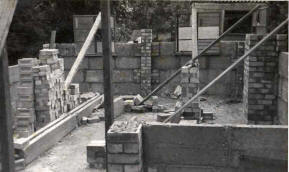
|
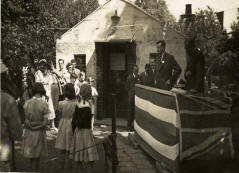
|
The official opening of the headquarters took place on Saturday 18th June 1955. The ceremony was performed by a local councillor, Lt. Cmdr. Staples R.N. After opening the building with a golden key he toured an exhibition of members' work. Outside the live steam track was in operation and as an extra attraction a 1931 Sentinel Steam Wagon visited the "Coach and Horses" car park. |
By September of 1957 thoughts were turning to the installation of mains electricity. The formal decision to proceed with this project was taken at the 1958 A.G.M. when thanks were given to the live-steam section for raising the necessary funds. Mains electricity was connected and used for the first time on 9th January 1959.
In January 1960 it was decided to purchase a locomotive for the society. One member offered one of his twin Speedy locomotives and this was subsequently purchased. Early in 1962 Hoover Ltd. offered the society a 5" gauge locomotive and trolley as a gift. This was accepted gratefully and the items were duly presented to the society at a special meeting on 2nd February 1962. The Locomotive, Butch, had been started in 1949 by Hoover's Apprentice Training School and was some four years older than the other club locomotive, Speedy.
In November 1964 the building of a continuous live steam track was suggested. The track would run partly on the society's own land and partly on adjacent council land. Some preliminary enquiries were made about the continuous track and at the 1966 A.G.M. the matter was again raised. Correspondence with the council began again in earnest that autumn, the council being generally in favour of our proposed use of the site.
1968 saw the introduction of a giant wooden Beam Engine replica as an Open Day crowd puller; our headquarters being well hidden from the main road the practice for many years had been to have something of note located at the top our entrance path to attract notice. A start on the continuous track was delayed because of planning permission difficulties.
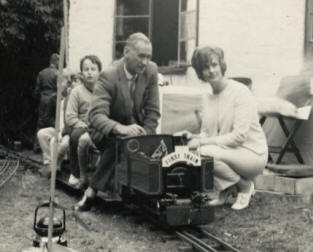
|
The notable event of 1969, however, was the progress with the continuous track. The lease was signed in June and by the Open Day in that month approximately one quarter of the track had been laid. Regular working parties were held and the circle was completed on 20th July. By chance Speedy, which had recently undergone a major overhaul, was available for a test steaming on that date and so became the first locomotive to steam round the entire circuit. Thereafter work continued in readiness for the official opening which took place on Saturday, 27th September. The track was opened by Mrs. Rosea Kemp - a radio weather forecaster - who drove a locomotive (suitably decorated with a headboard) through a tape stretched across the track. The single circuit still forms part of our miniature railway to this day. The railway was opened to the public on Sundays in 1970 but was not well supported, so in 1971 the public opening was changed to the first Saturday of the summer months, and results have improved steadily since then. In 1970 the first colour light signalling system was commissioned. |
The first edition of Ashpan, the society magazine, appeared in February 1973.
July 1975 saw the end of one of the most argued about club topics of all time - the club badge. In an amazing coup the design was agreed upon, the manufacturer contacted and the order placed, all within the space of a few weeks!
Later the same year the decision was taken to extend the railway to a terminal station on the front lawn. However work got off to a slow start as other projects required more immediate attention. Among these was the felling of many elm trees affected by Dutch Elm Disease. The track base of the main line continued to give problems and it was therefore decided to put the whole of the main line onto a concrete base.
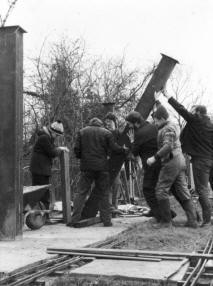
|
1980 saw the long discussed mains water supply installed and amenities plumbed in. At the same time the new station, Ickenham St. Giles, began to take shape. The Booking Office was constructed and the main station girders were erected by late 1981. To overcome the foreseen passenger trolley shortage when the extension was operational, a society project to build four new 5" gauge ground level trolleys was started |
At the November public run in 1981 Ickenham St. Giles was used in passenger service for the first time. A new signalling system was also in operation through much effort by the signalling department.
Work continued apace throughout the winter and spring on fully finishing the new station and by the end of April it was virtually complete. So it was at 3pm on Saturday 8th May 1982 the Reverend Paul Kelly, Rector of nearby St. Giles Church, unveiled the new station name board then rode on the first train out. Just fifteen minutes earlier, to the accompaniment of whistles and flags, the last passenger train had left Wood Halt; the society's station for the past thirteen years being named for its last two hours.
1983 started well, with the society having for the first time a club display stand at the Model Engineer Exhibition in January. The society has had a stand at every Model Engineer Exhibition since then.
1984 did not get off to such a good start. In February of that year, the clubhouse was subject to an arson attack which destroyed the wooden extension at the front and damaged the main club room. In retrospect the attack perhaps turned out to be a blessing in disguise as it instigated a rebuilding programme, which, over the next few years, saw the refurbishment of the main club room, the addition of a permanent extension that housed a kitchen and toilet, and a side room that would become the new home for the Model Railway Section of the society. This last room was built on the site previously used as the club workshop and so the late 1980s saw a new club project to build a new larger workshop building to the rear of the clubhouse and this was largely complete by 1991.
|
The 1990s also saw a number of improvements to the railway. At the same time as the workshop was going up a tunnel appeared on the railway, being covered by spoil form the workshop foundations. a new signal box was built and a new signalling system installed. After the new workshop was complete work started on a new loop line inside the original line. This too had a tunnel, much longer than the previous one. This loop came into use in 1997. Meanwhile Ickenham St Giles Station acquired a new booking office and this was in use by 2000 although final fitting out was not completed until 2003. |

|
Recent years have seen a number of projects providing minor enhancements to society facilities. The largest of these has been the complete reconstruction of the Ickenham St Giles station roof and this occupied the society for three years from 2010 to 2013.